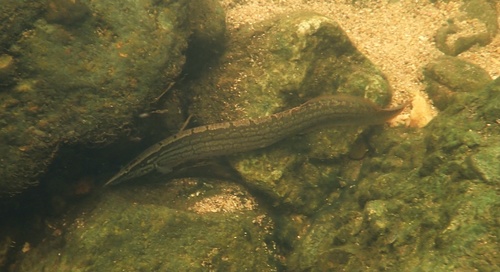
Zig-Zag Eel
The Atlantic bluefin tuna (Thunnus thynnus) is a magnificent and highly migratory species of tuna found in the Atlantic Ocean. Renowned for its size, speed, and commercial value, it plays a crucial role in the marine ecosystem. This species is a top predator. Unfortunately, it's also famous for its endangered status.
8 20 years
Lifespan
90 cm
Length
Least Concern
Conservation Status
5 km/h
Swimming speed
Carnivorous, Insectivorous
Diet
Local Migration
Migration
Appearance Overview
The Atlantic bluefin tuna is a large, torpedo-shaped fish with a metallic blue-black back and a silvery-white belly.
Color
Dark metallic blue on top, silvery-white underside
Body Shape
Torpedo-shaped and streamlined
Fins
Two dorsal fins, the first depressible; small finlets behind second dorsal and anal fin
Length
Up to 13 feet (4 meters)
Weight
Up to 2,000 lbs (900 kg)
Diet
Carnivorous, feeding on fish, squid, eels, and crustaceans.
Feeding Behavior
Highly active predator, using speed and coordinated hunting to capture prey. They can dive to significant depths.
Social Behavior
Forms large schools, often segregated by size; highly migratory.
Commercial Relevance
Extremely high value, especially in sushi and sashimi markets, driving significant fishing pressure.
Conservation measures
Subject to international fishing quotas, stock assessments, and monitoring programs, though enforcement can be challenging.
Status
Endangered
Threats
Overfishing (primarily for sushi/sashimi), bycatch in other fisheries, climate change affecting prey distribution.
Habitat Distribution
Depth Range
0-1,000 meters (typically in surface to mid-waters)
Geographic Range
Western and Eastern Atlantic Ocean, Mediterranean Sea
Preferred Environment
Temperate and subtropical waters; pelagic (open ocean)
Reproduction and Life Cycle
Breeding Habits
Spawns in warm waters, with two main spawning grounds: the Mediterranean Sea and the Gulf of Mexico. Spawning occurs in spring and summer.
Development Stages
Eggs hatch into larvae; larvae are planktonic and develop rapidly. Juveniles grow quickly, reaching maturity over several years.
Fecundity
Females can release up to 30 million eggs per spawning season.
Maturity Age
Matures at around 4-8 years in the Mediterranean, and 8-12 years in the Gulf of Mexico.
Faqs about Zig-Zag Eel
How long do Atlantic bluefin tuna live?
Atlantic bluefin tuna can live up to 40 years, although this is becoming rarer due to fishing pressure.
Where are Atlantic bluefin tuna found?
They are found in the Atlantic Ocean, both in the western and eastern parts, and also in the Mediterranean Sea.
Are Atlantic bluefin tuna migratory?
Yes, they are highly migratory, traveling vast distances across the Atlantic for feeding and spawning.
What are the natural predators of Atlantic bluefin tuna?
They have very few natural predators as adults, mainly large sharks and orcas. Young bluefin are more vulnerable.
Can Atlantic bluefin tuna be farmed?
While some aquaculture efforts exist, they often rely on capturing young wild tuna and fattening them, rather than breeding in captivity.
Are Atlantic bluefin tuna warm-blooded?
They are endothermic (warm-blooded), allowing them to maintain a higher body temperature than the surrounding water, which aids in swimming speed and efficiency.
How fast can Atlantic bluefin tuna swim?
They can reach speeds up to 43 mph (70 km/h) in short bursts.
What is the biggest threat to Atlantic bluefin tuna?
The main threat is overfishing, driven by high market demand. Illegal and unreported fishing also contribute.
Copyright @ Nature Style Limited. All Rights Reserved.
 English
English